
Image Source
If you’re making a home safe for infants or children, you should always sweat the small things – sharp corners, chemicals under the sink, electrical outlets and even laundry detergent pods are potential hazards for little ones. Forgetting anything? I didn’t mention a common household item that might not be top-of-mind for most: the small button batteries inside many of our electronic devices.
Every three hours, a child will visit an emergency department after consuming a battery. In fact, button battery ingestions have steadily risen since 2009 with 6,000 annual emergency visits across the nation, according to the American Academy of Pediatrics (AAP).
These small, coin-shaped batteries can be found in remote controls, thermometers, watches, calculators, hearing aids, flashlights, toys and even singing greeting cards. They might not initially seem like a choking hazard, but these batteries can become lodged in a child’s upper airway once ingested and cause serious tissue damage in as little as two hours. These batteries can also become easily lodged in a child’s ears and nostrils.
Lithium-containing button batteries still have a strong current, even after removal from the device they’re powering. Once the battery comes in contact with saliva, an alkalizing reaction can occur and erode through a child’s esophagus – leading to permanent damage and even death.
Following ingestion of a button battery, a child might present with:
- Wheezing
- Drooling
- Coughing
- Vomiting
- Chest discomfort
- Refusal to eat
- Gagging when attempting to drink/eat
You may not witness these ingestions, which are commonly mistaken for a swallowed coin. If you suspect your child has swallowed a button battery, a prompt response can prevent serious damage to a child’s airway. It’s also important to know if a magnet was co-ingested with the battery, as this could potentially cause further injury. X-rays of the child’s entire neck, esophagus and abdomen are typically necessary.
Do not make your child vomit.
Do not let him/her eat or drink anything.
If an open electronic device with a missing battery is found near your child, contact Poison Control’s battery ingestion hotline (1-800-498-8666) for guidance and head to your nearest emergency department immediately for further evaluation. Save this number in your phone ahead of time!
If a button battery has moved past the esophagus and into the stomach, your child might be sent home to wait for the battery to pass through his/her stool and requested to come back for repeat X-rays to monitor progress. Parents, you should monitor your child’s stools for any signs of active bleeding until the battery completely passes.
If a button battery is identified in the child’s esophagus, it will need to be removed as soon as possible endoscopically (with a small scope and camera) or surgically with the child under general anesthesia. The surrounding area may also be washed out with a solution to neutralize the remaining alkali to prevent further soft tissue damage.
Depending on the extent of surrounding damage, your child might also be admitted to the hospital for additional observation. Possible complications from a tear/hole in the esophagus (from erosive battery chemicals) include:
- Tracheoesophageal fistula (an abnormal connection between the trachea and esophagus)
- Lung abscess
- Tracheomalacia (tracheal wall collapse)
- Pneumothorax (lung collapse)
- Aspiration pneumonia
- Tear in a large blood vessel
Esophageal rest and repeat imaging will be ordered once the button battery is removed.
We increasingly rely on electronic items powered by these small coin-sized lithium batteries as technology advances and becomes more streamlined. It’s import to identify every battery-powered device in your home to ensure the battery is secure and preferably only accessible with a screwdriver. You can also use strong tape to secure battery components if they aren’t screwed shut. If this isn’t possible, these items (alongside any loose batteries) should be kept out of a small child’s reach or locked in a cabinet. Get on your child’s level and look for all kinds of choking hazards, including button batteries. Children should only play with these items under direct adult supervision.
Remember you can always contact Poison Control’s battery ingestion hotline at 1-800-498-8666 for guidance and more information. To learn more about the dangers of battery ingestion and prevention tips to consider, click here.
If you're interested in learning more about Texas Children's Center for Childhood Injury Prevention, click here.


